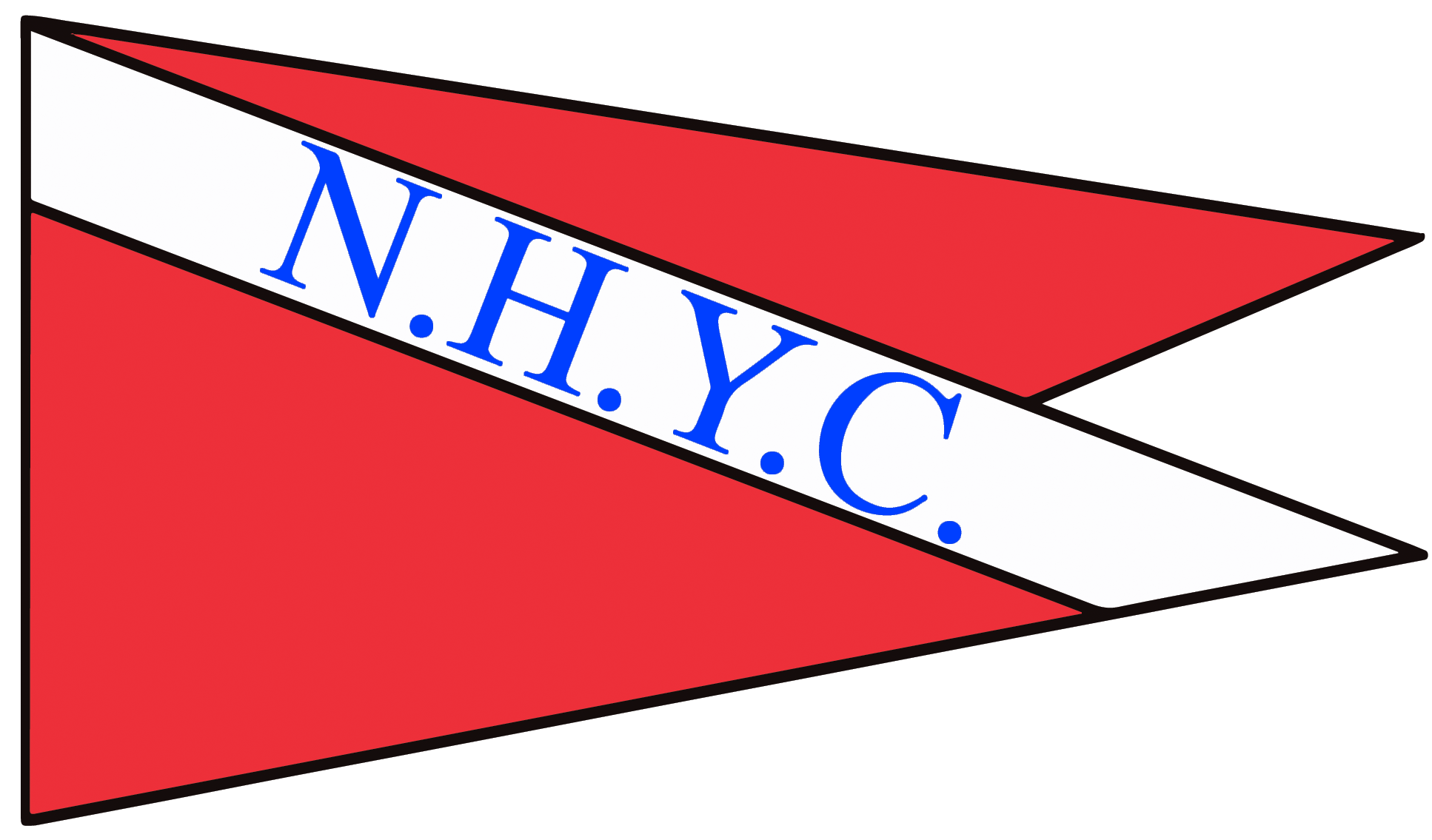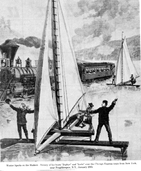
New Hamburg Yacht Club was incorporated on December 20th 1869 by the local millionaires, river captains and village residents as the “New Hamburg Ice Yacht Club”. It is considered the 6th oldest yacht club in the United States! The dues at the time were $3.00 for active members (those who owned yachts) and $2.00 for non-active members (those who did not). It was said to be the pioneer ice yacht club in this area. Summer boating wasn’t included in its activities until many years later.
To early Hudson River boatmen, the rocky point of land in the angle between the Hudson and the mouth of Wappinger Creek was known as High Point (New Hamburg) and the low area which projected into the river a few miles south was known as Low Point (Chelsea). Road records of 1770 show that there were shipping facilities in New Hamburg called “Hood Landing.” In 1815, John Drake Jr., had docks, a store, and 30 acres of land at that location which was assessed at $9,550 (a tidy sum in those days). It was then known as Wappingers Landing. Members of the Drake family had docks at New Hamburg for several generations. One of the Drakes is said to have been instrumental in having the road built between Hughsonville and Hopewell Junction. This was to encourage farmers to use his landing, and he built the first bridge over the lower Wappingers Creek known as “Drake’s Drawbridge.”
New Hamburg had another important early industry. Lime burning produced lime for building and also sweetened New Jersey’s acidic, sandy soil for agriculture. Dr. Benjamin Ely’s map of 1797 shows a lime kiln in New Hamburg. New Hamburg Yacht Club is now situated approximately where the “Old Lime Dock” was. The river front near the lime kilns was a favorite local bathing area called the “Sandy Bottom Shore.” When the railroad was built in the late 1840’s, excess stone was tossed onto the naturally sandy beach area.
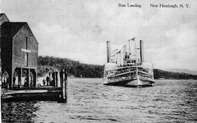
In the early 1820’s, New Hamburg had acquired a new industry. It would prove to be of greater importance than either the landing or the lime kilns. Charles Millard, who owned a lumber business based in Ulster County, he expanded his business by opening a lumber yard in New Hamburg. Since most of the lumber and log shipments were made by water, Millard’s son, Walter, branched out into ship building and freighting. He and a partner, Uriah Mills, built the barge “Lexington,” which carried freight up and down the Hudson River and the steamer, “Splendid,” which carried both freight and passengers.
It may well be at this time that the residents of the area decided to change the name of the community from High Point to New Hamburg, after the European port of Hamburg, Germany. When the railroad was built, one of the toughest problems facing workers was drilling and blasting the 900 foot New Hamburg tunnel. Rail service, both north and south, was established in 1849, before the tunnel was finished. Passengers were carried in a small boat from one train at Old Troy, just south of the mouth of the Wappingers Creek, to another, at what was to be the north end of the tunnel. Rather than ruining New Hamburg’s shipping trade, it continued to expand, as did the Millard Company and its related activities. The limestone was shipped from the Lime Dock and two other docks were doing big business in passengers and freight and freight. Nine boats stopped there every day. Some carried freight while others carried both freight and passengers. The glamorous river passenger boat of that period, the “Mary Powell,” stopped there, as well as other night boats.
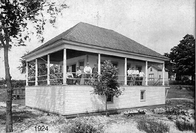
Irving Grinnell was the first Commodore and the leading spirit of the original club. He was a local millionaire who owned a river-front estate with a boat house that was a short distance south of Third Point. For some years the Grinnell boathouse was used as the yacht club’s headquarters. The Grinnell estate and the adjoining estate of Temple Bowdoin, another early member, is now known as Bowdoin Park of Dutchess County.
During the 1880s the club had many fast ice yachts (Mr. Grinnell owned six), and several expert boatmen. Most of the boats of the period were built by Jacob Buckhout, of Poughkeepsie, with most of the boat owners being either wealthy sportsmen, or owners of sailing vessels on which they earned their living when the river was open. During the winter, ice boating and their eternal games of dominos were the chief interests of these river captains. In 1881, the N.H.I.Y.C. had 14 active members and 9 non-active members.
The original club house stood one story on stilts with the ice boats stored underneath the building. The Zephyr was one of the first ice boats to be built in New Hamburg. James R. Lawson helped to construct many of these boats. Another of the first ice boats that sailed for the club was the Flut, owned by Captain Van Orden Carpenter. By experimenting, Capt. Carpenter learned that the Flut would make better time if he hung a heavy stone from her bowsprit. When ice yacht building became more precise, those who had laughed at Capt. Carpenter’s stone learned that he had employed a sound principal, even though he didn’t know it. A boat that is heavy on her rudder is never fleet. In the 1890s Archibald Rogers owned a large fleet of ice yachts. His largest was the “Jack Frost,” a large portion of which was built by the Herreschoffs, the famed designers and builders of the International Cup defenders. The “Jack Frost” and the “Icicle”, owned by Mr. Rogers neighbor, John Roosevelt, were then considered the “Kings of the Ice.” They were seldom sailed except in races for the Ice Yacht Championship Pennant of America, which originated at the N.H.I.Y.C. The big ice yachts of that period were frequently manned by three or four men. Older residents of New Hamburg can remember being paid $1.00 to ride the wings of such crafts, as ballasts. The last “Challenge Pennant of America” Ice Yacht race was held in 1922. It was won by the “Scout,” owned by Jacob Millard and sailed by Captain Frank V. Drake for the New Hamburg Ice Yacht Club. Captain William Drake, rear Commodore of the club in 1886, was one of the most active club members and one of the most famous of the river captains. He owned three or four excursion boats, all steamers. In 1886, the active members and the non-active members were:
Commodore – Irving Grinnell
Rear Commodore – Captain William Drake
Vice Commodore – Captain James Robert Lawson
Measurer -William Losee
Secretary – P.A. Mesier VanWyck
Treasurer – Peter LeRoy
River Men / Captains: William LeRoy, John W. Drake (W. Drakes son), M. W. Frank, Robert Collyer of Chelsea, Gerald Albertson
Wealthy Sportsmen: Temple Bowdoin, Charles R. Sands, James Banks, J.A. Norris, James Roosevelt (Step brother of the late president), Archibald Rogers (of Hyde Park)
Regular Members: J. Fisher Satterthwaite, William Van Wyck, Henry Van Wyck, Van Orden Carpenter, Abram Myers, Abram Lawson, Philip Schuyler, Cornelias Lawson, Charles LeRoy, H.H. Higginson, Isaac Miller, George Jackson, Charles VanAnden, Meredith LeRoy, Preston B. LeRoy, S.S. Howland, Marvin Griffin, George C. Lawson.
Many of the 1886 members are buried overlooking the river they so loved, in the now, over grown New Hamburg Presbyterian Cemetery on the hill, just east of the New Hamburg train station.
One of the more interesting positions in the club was that of measurer. It was William Losee’s job to measure each boat to determine it’s class and to lay out the courses over which the boats raced. There was a good deal of racing with the iced-over river covered with spectators on other ice yachts, skates or afoot. In these races, the boats sailed for the best time around a mapped, circular course. The races were usually limited to an hour and fifteen minutes. One course went from Stoneco (Trap Rock), across the river to Milton, down the west shore to Damskammer Point, then back to New Hamburg. There were different courses set up for different classes of boats. Courses were set up and changed depending on the direction and strength of the wind.
The river captains who sailed ice boats all winter, talked about ice boating all summer. Captain Hiram Relyea, of Athens and pilot of the steamer, “Daniel S. Miller,” heard a good deal of this conversation during the summer. He heard so much of it, in fact, that he finally told the local men that he would come to New Hamburg sometime and “clean you fellows up.” He did just that. First, he built an iceboat of a totally new design. It had a narrow cockpit for the helmsman and crew instead of the large, box cockpit that was in general use. He also used wire cable instead of the usual heavy side rails and set the mast three feet ahead of the runner plank to take weight from the rudder. Miller named his boat the “Robert Scott,” and with it, represented the Poughkeepsie Yacht Club when it challenged New Hamburg. The challenge didn’t turn out very well for us. Captain Frank Drake recalls that, “he trimmed our boys good and proper.” After that, most of the ice boats were built on the wire-tray or Scott lines.
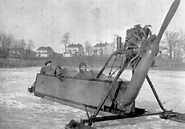
Interest in ice boating gradually waned, not only in New Hamburg but all along the river, as the old experts gradually died or grew too old to enjoy the sport. It reached its heyday in the early 1950s and was replaced by power boat racing. Many of the club members participated in power boat racing and an interest in recreational boating soon followed.
During the 100 plus years of the Yacht Club’s existence, it was, at times, inactive. In order to fit the changing needs of the community, the club was reorganized in 1902, 1938 and 1948. In 1902, it was changed for the express purpose of reviving ice yachting. A clubhouse was then built at the old lime dock. Although there was still a millionaire colony around the village, the estate owners did not come into the new organization. In 1911, the club was re-incorporated as the New Hamburg Yacht Club and old Lime Dock was acquired from Commodore William Workmen and his wife, Rowena. In 1913, the N.H.Y.C. had 22 active members, 127 non- active members and three honorary members. One of the enthusiastic younger members of that period was Jacob Millard, who won the original “Challenge Pennant of America” for the N.H.Y.C. with the Ice Yacht, “Scout.”
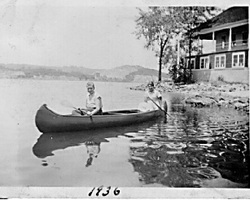
Between 1902 and 1920 the members became more and more interested in summer boating, first in small sailboats, then in Naphtha launches. During that period, there were beach parties at Third Point two or three times a month for the members, their wives and children. There were often 40 or 50 at these parties. Most of the group would go up the river in 10 or 12 launches, but some of the younger members would take their girlfriends up by canoe.
From the early 1900’s until 1938, the annual regatta was the high point of the club’s year. July 4th was the traditional date for the all-day affair that featured all sorts of water contests, canoe racing, canoe tilting, swimming races for all ages, and a baseball game between the single and married men of the community. There was plenty of refreshments and these regattas always ended with fireworks at night.
Interest in ice boating waned again, and the ice yachts were gradually stored in barns and sheds all over town. During that period the pool table in the clubhouse was the center of indoor winter activities. Many bitter contests were played there but that pool table meant that there was little room for other activities. In 1924, the members decided to raise the building. They did this by putting in a lower floor of concrete blocks. The second floor was reserved for meetings and pool. Claude Van Nostran was Commodore that year, and all the work of remodeling was done by members working summer evenings. For the next few years, the lower floor was used for dances, dinners and smokers. The Women’s Auxiliary was organized at that time, to take charge of refreshments.
Before the remodeling, the club had been very exclusive and had been reserved for the use of members only. The clubhouse gradually became more and more the center of the village activity in the summer. The sanded beach and bath houses were an attraction to the younger generation. Boys and girls went down to the clubhouse when they wanted to swim or boat, then sat on the deck or porch to look out over the river. Older residents found that the deck was a pleasant place to spend a summer afternoon or evening. It was especially pleasant after the club installed telescopes.
Interest in the club began to slip again and the club was reorganized in 1938, just before the young men began to enter the service. Additional land and water rights were acquired from Beatrice Jennings, of New Hamburg. During World War II, the river was practically closed to small crafts. Once again, the club became inactive and the property began to slide downhill. Windows were broken and the 75 foot flag pole came down. The bath houses became so run-down that they were torn down. Soon after they returned from service, Henry Scardefield and Frederick Croke asked permission to use the clubhouse for a commercial enterprise. They would make the necessary repairs, pay the taxes, keep the building ship-shape and return it anytime the club wanted it. During the year or so they used it, the property improved.
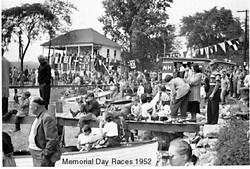
During that year, the Club had about 30 members who owned a couple dozen outboard motor boats. Under the new setup, the minimum age limit was dropped from 18 to 16, to take in the high school crowd. Younger boys and girls were to be allowed to use the club as long as they respected it. Once again, the Clubhouse became the hub of the village social life. Many of the members were out every night with outboards. Younger members would often go down to swim or just sit, look at the river and talk. During the reorganization, the officers hoped to revive the annual regatta. Although the fourth of July was too early to give them time to refurbish the clubhouse, re-sand the beach and build a new landing float and catwalk, the work was completed by the end of July.
From the 1950’s to the present day the club has had an annual celebration, like the July 4th regatta. In the 1950’s there were outboard races on Memorial Day weekend and Sunfish sailboat races during the 1960’s. In more recent times club functions are held throughout the summer with food, music and refreshments.
Some of the more interesting and significant events that occurred from 1950 through the 1970 time frame were:
During a hurricane in November, 1950, an empty fuel oil storage tank to the south of the club, floated loose and brushed the club wall on its journey up the river with the tide.
The N.H.Y.C. Centennial Celebration was held in 1969, at which time the club had 82 members.

In 1978, the club bought the property and house adjacent to the club from Arnie and Joan Cohen. This property, commonly referred to as “the rental property,” allowed for increased parking and yard space. It also increased our frontage on the river and currently provides the club with rental income and additional storage facilities. Another improvement to the club was the 1979 rebuilding of the interior stairwell, leading to the second floor.
The year 1985 was a very significant one for New Hamburg Yacht Club. Indoor plumbing was finally installed! It was also during this time that the dock system began to evolve, growing to the current 85 slips that exist today. Some of the changes that have taken place during the 1980’s and 1990’s were:
New windows on the 1st floor of the club, kitchen cabinets, appliances and floors for the rental house (1980-81).
Bathroom facilities within the clubhouse, new furnace and upper deck lounge (1985).
Electrical service to the club increased from 100 amps to 200 amp service, (the first time any of the docks had electrical service) and the dock system enlarged to accommodate 65 boats (1987).
Propane charcoal grill purchased for the for club and private functions (1988).
Water and electric were added to the dock system and bathrooms in the motor shed modernized and a shower installed (1989).
Dock system enlarged to accommodate 71 boats (1989).
Major renovations included: modernization & renovation of the kitchen, new siding, new roof, new porch over the river with a staircase to the ground, new windows, repairs and improvements to the rental house new outdoor tent (1990 -1991).
The purchase of a second tent for the grounds, lawn and flower gardens completely updated, parking lot enlarged and black topped (1994).
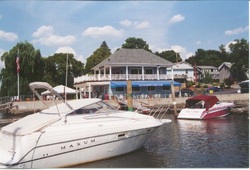
There is much more history about the club available. If you ever have the chance to speak to the life members of the club, please take advantage of their years of experience. Many life members have been in New Hamburg and around the club since they were children. Our Historian has a wonderful collection of N.H.Y.C. memorabilia that he would love to share with you. Over the decades the club has shifted it’s emphasis from exclusive ice yachting to sail and power boating, all enjoying the beautiful Hudson River. The clubhouse, grounds and marina facilities have all been built or renovated and maintained by the members. Membership is limited to 150 Regular Members, plus Life Members, and Honorary Members. The New Hamburg Yacht Club Ladies Auxiliary, founded in the mid-1920s, has played an important role in the success of the club. Their fund raising efforts, provide assistance in the many improvements and activities that are on-going that couldn‘t have been done as smoothly without them. Through the efforts of the New Hamburg Yacht Club Members, the club has grown in many key areas over the years and has become one of the more popular yacht clubs in the Hudson Valley. This is based on the list of individuals waiting to join the club’s limited membership.
